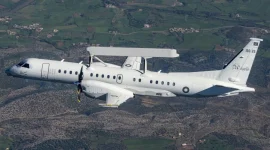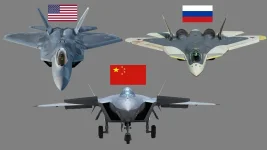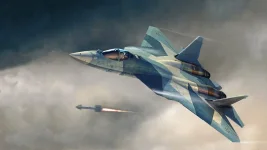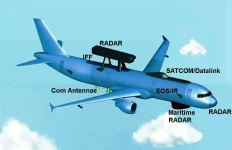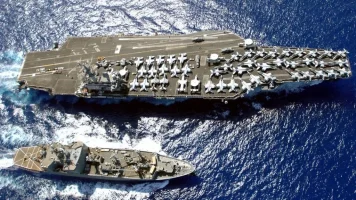- Views: 2K
- Replies: 12
As major global powers like the United States, China, and European nations push forward with developing sophisticated sixth-generation fighter jets across at least four distinct programs, experts are highlighting the increasing need for India to begin its own conceptual work on future air combat platforms.
With the world's fourth-largest air force, India faces a critical window to start planning to ensure its long-term aerial competitiveness.
The Indian Air Force (IAF) is currently invested in the development of its fifth-generation fighter, the Advanced Medium Combat Aircraft (AMCA). However, analysts suggest that now is the opportune moment to explore concepts for the subsequent generation.
Embarking on sixth-generation planning concurrently would strategically position India to avoid falling behind technologically once the AMCA enters service, ensuring the nation remains a relevant force in the evolving landscape of air warfare.
Sixth-generation fighter initiatives worldwide are set to redefine air combat. These programs promise significant advancements, including enhanced stealth capabilities, artificial intelligence aiding pilot decisions, integrated network warfare, the potential for directed-energy weapons, and flexible configurations allowing for either piloted or fully autonomous operation.
The United States is progressing with its Next Generation Air Dominance (NGAD) program for its Air Force and Navy, targeting deployment in the 2030s. China is also reportedly developing its own advanced platform, with state media hinting at achievements in AI and hypersonic technologies.
Meanwhile, Europe is pursuing two major collaborative projects: the Future Combat Air System (FCAS) led by France, Germany, and Spain, and the Tempest program involving the UK, Italy, and Japan, both exploring modular designs and the integration of drone swarms.
A common thread among these futuristic programs is a focus on superior connectivity, leveraging AI for cognitive advantages, and adaptability across different operational domains (air, land, sea, space, cyber).
Unlike fifth-generation aircraft, which emphasized stealth and fused sensor data, sixth-generation platforms are envisioned as interconnected "systems of systems." These networks would coordinate manned aircraft, autonomous drone companions often called 'loyal wingmen', and space-based assets dynamically.
For India, merely observing these global developments carries the risk of future technological obsolescence, particularly given the rapid evolution of potential threats in its region.
Currently, India's aerospace efforts are concentrated on the AMCA, a twin-engine, stealth-capable fifth-generation aircraft designed by the Aeronautical Development Agency (ADA) and Hindustan Aeronautics Limited (HAL). This platform aims to provide the IAF with a modern, versatile fighter featuring supercruise (sustained supersonic flight without afterburners), state-of-the-art avionics, and indigenous radar systems.
The AMCA project targets a first flight around 2028, with induction planned for the mid-2030s. An initial Mark 1 version is expected to use General Electric F414 engines, followed by a Mark 2 equipped with a more powerful, domestically developed engine.
While the AMCA marks a vital step forward for India's indigenous defence capabilities, its projected service entry date means that sixth-generation fighters developed by other nations may already be operational.
The IAF, operating a large fleet of approximately 1,700 aircraft, faces the ongoing challenge of replacing aging platforms like its MiG-21s, Jaguars, and Mirage 2000s. While the AMCA is essential for this modernization, strategic planners argue India must look further ahead to secure long-term air superiority, especially with China deploying its J-20 stealth fighter and pursuing its own next-generation ambitions.
The Case for Starting Sixth-Generation Planning Now
Initiating conceptual work on a sixth-generation fighter program is presented not as a diversion from the ongoing AMCA project, but as a necessary strategic investment in the future. Several factors underscore the urgency for India to begin this process:- Avoiding the 'Catch-Up' Cycle: India has historically faced lengthy development timelines for indigenous fighter programs, such as the Light Combat Aircraft (LCA) Tejas. Starting research into sixth-generation technologies like AI, quantum computing, advanced materials, and directed energy now, while the AMCA progresses, could prevent a future capability gap when today's cutting-edge technology becomes tomorrow's standard.
- Regional Security Imperatives: China's significant military modernization efforts, including its reported pursuit of sixth-generation capabilities, present a direct strategic challenge. Ongoing border tensions and Beijing's increasing air power projection necessitate that India develops capabilities to maintain effective deterrence.
- Leveraging Technological Strengths: Sixth-generation fighters will heavily rely on artificial intelligence, machine learning, and advanced human-machine interfaces. India's established strengths in information technology and software development provide a unique foundation for innovation in these crucial areas, potentially benefiting both the AMCA and future platforms.
- Strengthening Global Partnerships: Actively pursuing a domestic sixth-generation initiative could enhance India's position in international collaborations, potentially facilitating technology sharing with partners like the US, UK, or France, who are already investing heavily in this domain. It would build upon India's current observer status in the Tempest program, offering greater leverage in negotiations.
- Developing the Defence Industrial Base: A national sixth-generation program would act as a significant catalyst for India's defence industry, driving advancements in critical areas like materials science, propulsion technology, and cybersecurity. This aligns with the "Make in India" initiative, fostering self-reliance, creating high-value jobs, and encouraging greater private sector involvement in national defence projects.

